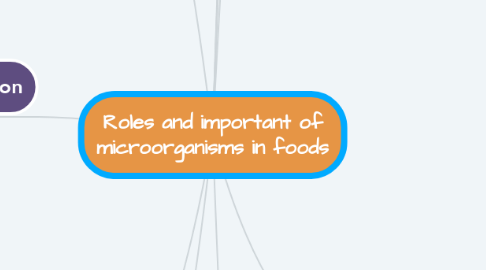
1. Lactic acid bacteria
1.1. Type of lactic bacteria
1.1.1. 1.Mesophilic LAB(20-30°C) -Lactococcus,Leuconostoc,Pediococcus
1.1.2. 2.Thermophilic LAB (up to 45°C) -Lactobacillus + Streptococcus -Yogurt
1.2. Lactic acid EX. -Lactococcus -Streptococcus
1.3. Most are aerotolerant anaerobes
1.4. EX. Pickles , fermented meat , yogurt, cheese
2. Grow 40 – 90 0C, with optimum growth at 55 – 65 0C.
3. Grow faster and are more resistant to high temperatures
4. Ex. E.coli, salmonella Typhi, Vibrio cholera
5. No specific receptors
6. The main cause of spoilage
6.1. Ex. Fruits have a change in color
7. 5. Indicator M/O (quality assurance)
7.1. High densities
7.2. Non-pathogenic
7.3. Easily delected
7.4. Indicator organism for product safety
7.4.1. E.coli
7.4.2. Coliform and fecal coliforms
7.4.2.1. Fecal : found in the feces of warm-blooded animals if found it’s dangerous. Ex. Eschricia
7.4.2.2. Non-fecal: found in soil and plants but not found in feces, including Enterobacter, klebsiella, Citrobacter.
7.4.3. Enterobacteriaceae
7.5. Important microorganisms in food
7.5.1. Bacteria
7.5.1.1. Most bacteria are harmless BUT cause food spoilage.
7.5.1.2. Some bacteria can produce toxic substances.
7.5.1.3. Some secret enzymes to produce food.
7.5.1.4. The most important are Escherichia , Salmonella,Psedomonas ,Bacillus,Clostridium , Lactobacillus and Staphylococcus.
7.5.2. Yeast
7.5.2.1. Spoilage in acidic , sweet ,salty or high in fat (not pathogenic)
7.5.2.2. Destroyed from77 C
7.5.2.3. Important yeasts in food: Saccharomycetaceae and Crytococcaceae
7.5.3. Mold
7.5.3.1. Found in soil and dust in the air
7.5.3.2. Can grow and survive in many environments concentrated solutions of acids, salts.
7.5.3.3. Need oxygen
7.5.3.4. Grow in refrigerator
7.5.3.5. Important mold in food: Aspergillus, Alternaria, Botrytis, Penicillium, Rhizopus and Mucor
7.5.3.5.1. Cause spoilage
7.5.3.6. Some species are produce mycotoxins.
8. 4.Food production
8.1. Yeast
8.1.1. Saccharomyces cerevisiae most frequently on fruit and vegetables
8.1.2. They all ferment glucose such as sucrose , maltose and raffinose ferment the animal sugar lactose.
8.1.3. EX. Beer,Wine,Bread,Sake,Sato
8.2. Mold
8.2.1. Mostly use with cereal grain; tempeh, soy sauce
8.2.2. Synthesis of enzymes
8.2.2.1. Hydrolyze food compositions and then develop a desirable texture, flavor and aroma.
8.2.2.2. Decrease or eliminate anti nutritional component.
8.2.2.3. Improve nutritional quality of the fermented product.
8.2.3. Important enzymes(hydrolase food)
8.2.3.1. Proteolytic enzyme:Protease in cheese ripening, bread making and meat tenderization.
8.2.3.2. Carbohydrase:alpha - amylase in bread and beverages.
8.2.4. starter Culture
8.2.4.1. Normal microflora =Naturally presented microbes in typical fermented foods.
8.2.4.1.1. -Addition of previous fermented product.
8.2.4.1.2. -Applied to traditionally fermented foods.
8.2.4.2. Pure culture =Select & special organisms
8.2.4.2.1. - 1 strain of 1 organism or mixed strains of 1 or several organisms
8.2.4.2.2. - To assure proper reaction occur & to obtain larger yield of high quality products.
8.2.5. Type of fermented food
8.2.5.1. Dairy products
8.2.5.1.1. EX.Cheese , Yogurt ,Milk
8.2.5.2. Meat products
8.2.5.2.1. EX.Salami,sausage
8.2.5.3. Cereal products
8.2.5.3.1. EX. bread , Rice
8.2.6. EX.Soy sauce ,tempeh
9. 2.Food Spoilage
9.1. Spoilage causes
9.1.1. Fish
9.1.2. A product may become unacceptable
9.1.2.1. Physical
9.1.2.1.1. Insects damage
9.1.2.1.2. Drying
9.1.2.1.3. Discoloration
9.1.2.2. Chemical
9.1.2.2.1. rancid it
9.1.2.3. Microbial
9.1.2.3.1. Fungi
9.1.2.3.2. Bacteria
9.1.2.3.3. Yeasts
9.1.3. Illness
9.1.3.1. Dominate spoilage in warmer climates.
9.1.3.2. Consequences economic loss & health harmful food
9.1.4. Perishable
9.1.4.1. Milk
9.1.4.2. Meat
9.1.5. Colors
9.1.6. Quality changes
9.1.6.1. Taste
9.1.6.2. Texture
9.1.6.3. Appearance
9.1.7. Semi-Perishable
9.1.7.1. Fruit & vegetables
9.1.8. Non-Perishable
9.1.8.1. Cereal
9.2. Mold
9.2.1. Aspergillus
9.2.1.1. Low water activity than Penicillium spp.
9.2.1.2. Ex. grains, dried beans, peanuts, tree nuts, and some spices.
9.2.1.3. Many produce mycotoxins: aflatoxins, ochratoxin
9.2.1.4. Odors
9.2.2. Are filamentous fungi.
9.2.3. They require oxygen for growth pH 3 - 8 and low water activity (0.7-0.8)
9.2.4. Ex. Dried foods.
9.2.5. Spores can tolerate harsh environmental conditions but most are sensitive to heat treatment.
9.2.6. Produce a number of toxic and carcinogenic mycotoxins.
9.2.7. Some spoilage molds are toxigenic while others are not.
9.3. Acinitobacter
9.4. Bacteria
9.4.1. Psychrotrophic Bacteria
9.4.1.1. Aerobic :
9.4.1.1.1. Pseudomonas
9.4.1.2. Type of food:
9.4.1.3. Sporeformer:
9.4.1.3.1. Bacillus and Clostridium spp.
9.4.1.4. Facultative anaerobic :
9.4.1.4.1. Leuconostoc mesenteroides etc.
9.4.2. Thermophilic Bacteria
9.4.2.1. Type of food:
9.4.2.1.1. Pasteurization, under process of thermal process, post heat contamination
9.4.3. Aciduric Bacteria
9.4.3.1. Can grow at pH 4.6 or below
9.4.3.1.1. aciduric or acidophilic.
9.4.3.2. Type of food :
9.4.3.2.1. fruit juices, pickles, salsa, salad dressings, mayonnaise, and fermented sausages.
9.4.3.3. Lactic acid bacteria
9.5. Yeasts
9.5.1. Subset of fungi
9.5.1.1. Ex. Includes molds and mushrooms
9.5.2. Do not produce toxicant
9.5.3. Can be used to produce bread and alcoholic drinks
9.5.4. Penicillium
9.5.4.1. Dominate spoilage in temperate regions
9.5.4.2. Use for producing antibiotics and blue cheese
9.5.4.3. But many species are spoilage organisms and produce mycotoxins
9.5.4.3.1. Ex. Patulin, ochratoxin
9.5.4.4. Penicillium spp. cause visible rots on citrus, pear, and apple fruits.
9.5.5. Cause spoilage in a high sugar or salt content
10. Gram-positive , nonsporeforminhg
11. 3.Food Sources
11.1. Yeasts
11.1.1. Marmite
11.1.1.1. Yeast Paste
11.2. Bacteria
11.2.1. Spirulina platensis
11.2.1.1. A Cyanobacterium
11.3. Fungi
11.3.1. Mushrooms are actually a microorganism
11.4. Algae
11.4.1. Chlorella
11.4.1.1. Fresh water
11.4.2. Dunaliella
11.4.2.1. Salt water
12. 1.Foodborne Pathogens
12.1. fluctuate temperature of chilling storage
12.2. Yeasts can grow with or without oxygen
12.3. Food intoxication
12.3.1. Bacteria: Salmonella spp., Listeria monocytogenes, Compylobacter jejuni, Vibrio parahaemolyticus, Vibrio vulnificus, and Yersinia enterocolitica
12.3.1.1. Integral part cell wall
12.3.2. Ex. Maple syrup, pickles, sauerkraut fruit juice, surface of meat and cheese
12.3.3. Is caused by eating toxins
12.3.3.1. Exotoxin
12.3.3.1.1. Moderately toxin
12.3.3.1.2. Excreted by organism
12.3.3.1.3. It is polypeptide (protein)
12.3.3.1.4. unstable, heat labile (60 C)
12.3.3.1.5. Highly toxin
12.3.3.1.6. Specific receptors
12.3.3.1.7. No fever
12.3.3.1.8. Gram positive
12.3.3.1.9. Ex. Staphylococcus aureus, Bacillus cereus, botulism toxin
12.3.3.2. Endotoxin
12.3.3.2.1. Gram Negative
12.3.3.2.2. It’s lipopolysaccharide complex
12.3.3.2.3. Stable, heat tolerant
12.3.3.2.4. Cause fever
12.3.3.2.5. Cannot be denatured (on boiling)
12.4. Food infection
12.4.1. Is caused by eating food containing live bacteria
12.4.1.1. Cause illness
